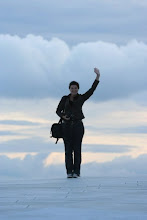Kedves met.net-esek! Mivel látom, hogy felfedeztétek az oldalt (és mivel ma sem sikerült semmit lefotóznom), itt küldök külön Nektek még egy kis régi légköroptikát. Ezúttal nem középkor, hanem ókor, viszont nagy hatással volt a középkori tudósokra. Idősebb Plinius-tól a Historia Naturalis 2. könyvéből egy idézet. Az i.sz. I. században így írta le a melléknapokat, mellékholdakat és naphalot. Bocs, nincs türelmem lefordítani magyarra :) Üdv, és sok szép jelenséget a hétre!
The quotation is not medieval this time, but had strong influence on scholars of the Middle Ages. Pliny the Elder described the parhelia, moondogs and halos in Book II. of his Natural History in the following way. 1st century A.D. and very interesting:
***
XXVIII. Stars are also seen throughout the daytime in company with the sun, usually actually surrounding the sun's orb like wreaths made of ears of corn and rings of changing colour - for instance, when Augustus Caesar in early manhood entered the city after the death of his father to assume his mighty surname. Similar haloes occur round the moon and round the principal fixed stars. XXIX. A bow appeared round the sun in the consulship of Lucius Opimius and Quintus Fabius, a hoop in that of Gaius Porcius and Manius Acilius, and a red ring in that of Lucius Julius and Publius Rutilius. [...] XXXI. Again, several suns are seen at once, neither above nor below the real sun but at an angle with it, never alongside of nor opposite to the earth, and not at night but either at sunrise or at sunset. It is also reported that once several suns were seen at midday at the Bosphorus, and that these lasted from dawn till sunset. In former times three suns have often been seen at once, for example in the consulships of Spurius Postumius and Quintus Mucius of Quintus Marcius and Marcus Porcius, of Marcus Antonius and Publius Dolabellal and of Marcus Lepidus and Lucius Plancus; and our generation saw this during the principate of his late Majesty Claudius, in his consulship, when Cornelius Orfitus was his colleague. It is not stated that more than three suns at a time have ever been seen hitherto. Sky portents - recorded instances: torches, shafts, sky-beams, sky-yawning, colours of the sky, sky-flame, sky-wreaths, sudden rings, prolonged solar eclipses, several suns, several moons, daylight at night, burning shield; an unique sky-portent XXXII. Also three moons have appeared at once, for instance in the consulship of Gnaeus Domitius and Gaius Fannius.
Tuesday, 27 February 2007
Subscribe to:
Post Comments (Atom)






No comments:
Post a Comment